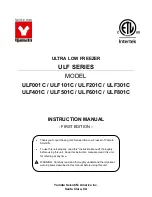
English
using premium quality, fresh food.
- Lie the food to be frozen horizontally in the freezer com-
partment so that it can freeze as quickly as possible, even
in the middle;
- In order to prevent frozen food from thawing, arrange
fresh food so that it does not come into contact with
already frozen food. When freezing small amounts of food
(1-2 kg) there is no need to adjust the thermostat knob.
When freezing larger amounts, follow the advice given in
the control panel user manual.
Important
- Never store bottled drinks, especially carbonated, in the
freezer compartment or low temperature compartment; as
the drinks freeze, the contents expand and the bottles can
explode.
Calendar
The symbols on the calendar inside the freezer door indicate
the various products that can be frozen. The numbers indicate
the recommended storage time, expressed in months, for
each food type.
The higher number can be taken as the valid storage period
for premium quality products, properly frozen.
- 7 -
Defrosting food
For optimum results when cooking frozen food, allow it to
defrost first in the refrigerator or at ambient temperature: tha-
wing time will be shorter at ambient temperature. If you need to
cook food quickly, as long as the portions are small, you cook it
straight from frozen, increasing the cooking time slightly.
Average to larger portions can be defrosted in a microwave
oven before cooking.
Once thawed, food perishes quickly and must therefore be
used within12-24 hours. Once cooked, (boiled or cooked) it
can be frozen again.
DEFROSTING
The frost that builds up on the inside walls of the refrigerator
defrosts automatically each time the compressor stops. This
defrost water is routed to a special basin positioned above
the compressor at the rear of the appliance, from where it
evaporates thanks to the heat generated by the compressor.
Excessive build-up of frost can be caused by the thermostat
being turned up too high or by poorly fitting door seals.
Remember to clean the defrost water drain
outlet from time to time (positioned in the
middle of the drain channel in the refrigerator).
Defrosting the freezer compartment
It is perfectly normal for frost and ice to form in the freezer
compartment. Nonetheless, if the layer becomes excessively
thick, it acts an insulator and compromises cooling. If ice for-
mation in the compartment is excessive, check that the free-
zer door closes properly and that the door seals adhere well
and are in a good state of repair. Defrost the freezer com-
partment periodically, and whenever the layer of icereaches
a thickness of around 5 mm. Up to a thickness of around 3-4
mm, ice can be removed using a plastic scraper. If the layer
of ice is thicker, proceed as follows:
1. 24 hours before defrosting, turn the thermostat knob to the
highest setting or select the SUPER FREEZING function
(if provided). Frozen food will be adequately frozen and
may be removed from the appliance.
2.
Dry your hands thoroughly (or wear rubber gloves
if possible) to avoid damage to skin in the event
you inadvertently touch the ice.
3. Remove frozen food (empty all food from the refrigerator
compartment too), wrap and store it in a dry, cool place.
4.
Unplug the appliance from the mains.
5. Leave the appliance door open and scrape the ice care-
fully off the walls using the plastic scraper; collect the pie-
ces of ice and allow them to melt in the kitchen sink.
6. Remove the defrost water drain channel (if provided)
from the bottom of the appliance and position a basin to
collect the defrost water. If your appliance does not have
a defrost water drain channel, place a towel in front of
the appliance and continually remove the water with the
help of a sponge.
Summary of Contents for CB1-375
Page 14: ......

































